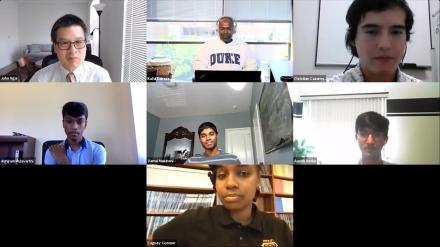
After the past year and a half of pandemic-induced isolation, the 7th Annual BRAIN Initiative Investigators Meeting held last month truly felt like a celebration. Together, we have persisted through research stoppages and met challenges to getting work done despite the disruptions caused by COVID-19. This year’s meeting – with more than 3,500 registrants – showcased the great work that did get accomplished, and I could sense how much we all yearn for an in-person meeting next year. Creative insights and new ways of looking at a problem are born of impromptu personal interactions: not just at scientific meetings, but also in the hallway, in the cafeteria, and in lab outings. I hope you’ll join in my optimism for many more such interactions in the near future.
Delivering on the anticipation and excitement, this year’s meeting was full of newfound data, many lively panels, and rich scientific symposia – visiting a range of topics. These included neural dynamics of brain stimulation; molecular engineering of neural networks; diversity and equity in underserved research settings; the social brain; and integrative approaches to a functional cell census. All meeting presentations are publicly viewable until June 2022, and I encourage you to check out any sessions you may have missed. I’d like to highlight here a few themes that surfaced, because I believe they will help us chart our work ahead.
Circuit Complexity
My first takeaway is yet another reminder of how complex the brain really is – and how challenging it is to study. Of course, that’s always what you hear when describing this living collection of nearly 100 billion neurons plus the glial and other cell types that comprise the human brain. But unlike a computer built by people, brain function has been sculpted by millions of years of evolution with no accompanying user manual. For the most part, we still remain in the dark about the computations underlying behaviors. But investigators are making headway with carefully designed models developed with the quantitative biology skill set that has become so central to BRAIN.
Meeting sessions examined what we are learning about the neural underpinnings of behaviors, such as social communication and sensation. A deliberately diverse range of model systems, including fruit flies, naked mole rats, and many others, are informing this work to develop predictive models of simple behaviors. It’s clear that quantifying behavior remains a critical task; we’re learning that disaggregating behaviors into segments that can be studied as units is likely to be a good strategy. Yet these investigations are just the first step, and we have a long way to go to predict and manipulate circuits at will.
In addition to critical studies of circuit readouts in model systems, investigation using measurements with human brains is also advancing well. Several studies presented by U.S. BRAIN-funded investigators are providing a glimpse into the highly individualized, state-dependent nature of circuit activity in human brains altered by various diseases, including Parkinson’s, schizophrenia, depression, and others. A clear lesson from these discussions is that careful experimentation and theory need to be tightly coupled.
Evolution Is Our Teacher
A second takeaway from the meeting also isn’t a new concept, but it recapitulates a centrality of biology: that evolution is our best teacher. The NIH BRAIN-supported cell census project has been remarkably successful in elucidating the organizational principles underlying the complexity of cell types in the mammalian brain. This large-scale effort to create a reference set of cell types is revealing not only extensive conservation across species from mice to marmosets to humans, but a few interesting exceptions as well. One fascinating upshot is that although a human brain is roughly 1,000 times larger than a mouse brain, the cell types that comprise mammalian brains are mostly conserved. Understanding the biological rules that define cell types across species may also help us better predict which animal models might be appropriate for understanding human diseases and therefore for the development of targeted treatments.
By uncovering molecular and functional properties of brain cell types, the BRAIN Cell Census Network (BICCN) project is also providing a blueprint for how to modify neurons to treat diseases with targeted genomic approaches, such as CRISPR. Now is the time to look to similar, past endeavors such as the Human Genome Project, for new directions and guidance on ethical, legal, and social issues that must be coordinated with biological investigation. In particular, we must keep in mind that the remarkable variation among humans holds the secrets to the genetic underpinnings of disease. Thus, any reference dataset will be limited in its utility if it fails to represent the diversity of people affected by the neurological and neurodegenerative conditions BRAIN is working to address.

The Thrill of Discovery for All
A third thread that wove through all the presentations was the inherent value of diversity in absolutely everything we do. Open-minded, unbiased pursuit of knowledge is the ground truth of scientific investigation – calling upon us, collectively, to turn over every single rock.
I have been struck throughout my career how people – be they colleagues, trainees, or my own teachers – who are different from me enrich the way I think and make me challenge assumptions. Often, these are individuals whose innate talent may have been obscured by various barriers limiting access to what has become a very narrow path to becoming a scientist. These alliances have been remarkably rewarding – watching a trainee take flight is a reward for all of us who invest the time into providing opportunities and facilitating learning.
In keeping with NIH BRAIN’s efforts to leverage diverse perspectives to drive scientific excellence, this year’s meeting included several sessions devoted to equity and inclusion, including a look at the social brain. We spoke about the value of exciting the next generation, and how many BRAIN investigators are pursuing this creatively and vigorously. NIH BRAIN will do its part to shine a light on these important efforts to maximize our talent pool and new opportunities for eager and creative individuals to participate in this fascinating enterprise.
These themes are one window into three days of lecture, discussion, and innovation; for another perspective, see that from the BRAIN Initiative Alliance. I look forward to seeing what new layers researchers will expose in the year ahead, and, as always, I welcome ideas about more ways to share BRAIN results and inspiration.
